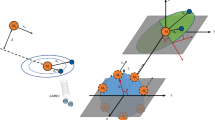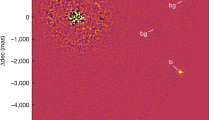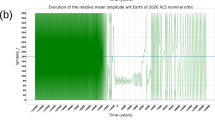Abstract
The planet recently discovered1 orbiting the star 16 Cyg B has the largest eccentricity (e= 0.67) of any known planet. Planets that form in circumstellar disks are expected to have nearly circular orbits, although gravitational interactions in a system of two or more planets could generate high-eccentricity orbits2,3. Here we suggest that the eccentric orbit of 16 Cyg Bb arises from gravitational interactions with the distant companion star, 16 Cyg A. Assuming that 16 Cyg Bb formed in a nearly circular orbit, with the orbital plane inclined between 45° and 135° to the orbital plane of 16 Cyg A, and that there are no other planets with a mass similar to that of Jupiter within 30 astronomical units (AU, the average distance between the Earth and the Sun), then 16 Cyg Bb will oscillate between low-eccentricity and high-eccentricity orbits. The transitions between these orbits should occur every 107–109 years, with the planet spending up to 35 per cent of its lifetime with an eccentricity e> 0.6. These results imply that planetary orbits in binary stellar systems commonly experience periods of high eccentricity and dynamical chaos, and that such planets may occasionally collide with the primary star.
This is a preview of subscription content, access via your institution
Access options
Subscribe to this journal
Receive 51 print issues and online access
$199.00 per year
only $3.90 per issue
Buy this article
- Purchase on Springer Link
- Instant access to full article PDF
Prices may be subject to local taxes which are calculated during checkout
Similar content being viewed by others
References
Cochran, W. D., Hatzes, A. P., Butler, R. P. & Marcy, G. W. Bull. Am. Astron. Soc. 28, 1111 (1996).
Weidenschilling, S. J. & Marzari, F. Nature 384, 619–621 (1996).
Rasio, F. A. & Ford, E. B. Science 274, 954–956 (1996).
Gauss, K. F. in Collected Works Vol 3, 331 (1818).
Touma, J. & Tremaine, S. Icarus (submitted).
Kozai, Y. Astron. J. 67, 591–598 (1962).
Hale, A. Astron. J. 107, 306–332 (1994).
Fekel, F. C. Astrophys. J. 246, 879–898 (1981).
Weinberg, S. Gravitation and Cosmology 194 (Wiley, New York, 1972).
Rasio, F. A., Tout, C. A., Lubow, S. H. & Livio, M. Astrophys. J. 470, 1187–1191 (1996).
Mazeh, T., Krymolowski, Y. & Rosenfeld, G. Astrophys. J. (submitted).
Innanen, K. A., Zheng, J. Q., Mikkola, S. & Valtonen, M. J. Astron. J. (submitted).
Author information
Authors and Affiliations
Rights and permissions
About this article
Cite this article
Holman, M., Touma, J. & Tremaine, S. Chaotic variations in the eccentricity of the planet orbiting 16 Cygni B. Nature 386, 254–256 (1997). https://doi.org/10.1038/386254a0
Received:
Accepted:
Issue Date:
DOI: https://doi.org/10.1038/386254a0
This article is cited by
-
The evolution of hierarchical triple star-systems
Computational Astrophysics and Cosmology (2016)
Comments
By submitting a comment you agree to abide by our Terms and Community Guidelines. If you find something abusive or that does not comply with our terms or guidelines please flag it as inappropriate.



